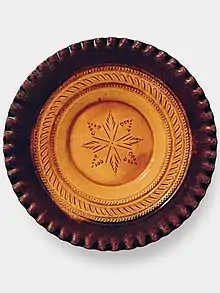Latgalian pottery
Latgalian pottery[1] (Latgalian: Latgolys pūdnīceiba, Latvian: Latgales podniecība) or Latgalian ceramics (Latgolys keramika, Latgales keramika), also known as Silajāņi ceramics[2] is the best-known subset of Latvian pottery. The region of Latgale historically has been the most prolific producer of wares.[3] Latgalian ceramics rose to the popularity in the Soviet period, when art historian Jānis Pujāts wrote books about the best Latgalian ceramicists and organized several exhibitions to showcase their works.

Types of ware
Most of the types of wares of Latgalian ceramics were used in the local households for everyday use. Examples include vuoraunīks (a pot for cooking), madaunīks (a pot for honey storage), sloinīks (a pot for storing fruit preserves), stuodiņs (a pot for storing sour cream), ļaks (a vessel for storage of oil), pīna pūds (a pot for storing cow's milk), kazeļnīks (a pot for goat milk storage), puorūss (lit. "over-handle", a vessel for bringing food to the field), bļūda (bowl), kryuze (a jug or a mug, most often for beer or milk).[4]
For decorative purposes, Latgalian ceramicists were making candlesticks (svečturi) and human, animal, folk figure shaped ocarinas (sviļpaunīki).[5]
References
- Gross, Daina. "Latgalian Pottery". Latvian Culture Canon. Retrieved 2013-07-26.
- Pujāts, Jānis (1957-06-01). "Silajāņu keramikas meistari" (11 ed.). Zvaigzne. p. 16.
- Pujāts, Jānis. Latgales keramika. Rēzekne:Latgales kultūras centra izdevniecība, 2002, pages 20-26
- "Ceramics of Latgale". futureofmuseums.eu. Retrieved 2013-07-26.
- Pujāts, Jānis (1957-06-01). "Silajāņu keramika" (6 ed.). Karogs. p. 115-117.
External links
| Wikimedia Commons has media related to Latgalian ceramics. |
- Virtual exhibition about Latgalian ceramics @ Latgale Culture History Museum
